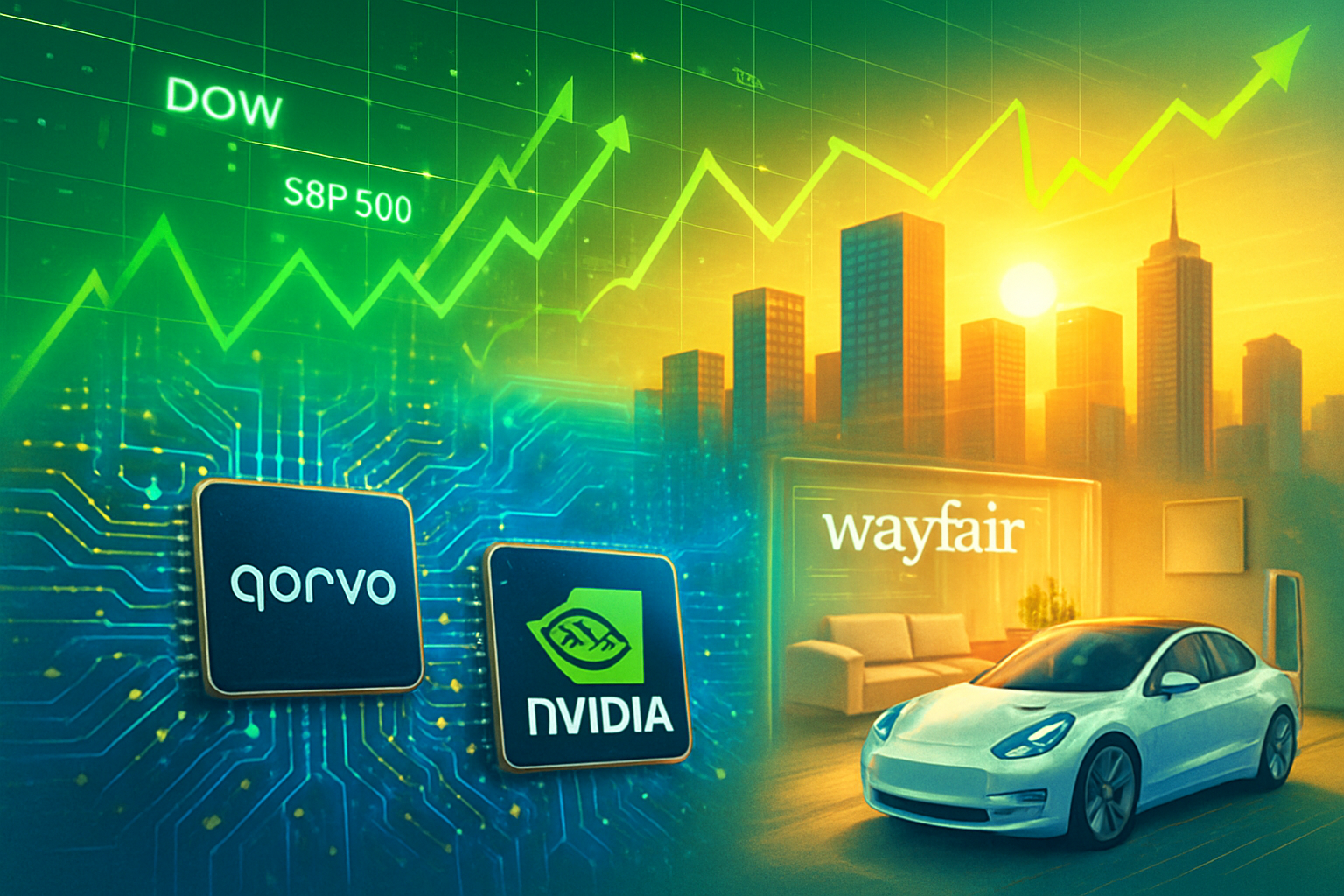
New York, NY – October 28, 2025 – The U.S. stock market commenced trading today with a resounding surge, as the Dow Jones Industrial Average, S&P 500, and Nasdaq Composite all opened significantly higher, pushing further into uncharted record-high territory. This robust opening signals a continuation of the powerful bullish sentiment that has characterized recent market activity, fueled by investor optimism surrounding upcoming economic catalysts and strong corporate performance.
Today's impressive start underscores a market brimming with confidence, even as crucial events loom on the horizon. Investors are keenly anticipating a Federal Reserve meeting, with expectations of an interest rate cut, alongside a series of pivotal tech earnings reports and high-stakes trade discussions between President Donald Trump and Chinese leader Xi Jinping. The market's upward trajectory suggests a collective belief in favorable outcomes from these events, setting a vibrant tone for the week.
Market Opens at Record Highs Amidst Bullish Momentum
The morning bell on October 28, 2025, heralded another day of significant gains across the major U.S. indices, extending a remarkable run of record-breaking performances. The Dow Jones Industrial Average (NYSE: DJIA) led the charge, climbing approximately 294 points, or 0.6%, shortly after the opening. Similarly, the S&P 500 (NYSE: SPX) advanced by 0.2%, building on its historic close above the 6,800 level yesterday, marking its 35th record close of the year. The technology-heavy Nasdaq Composite (NASDAQ: IXIC) also joined the rally, rising 0.5% in early trading, reflecting robust confidence in the tech sector.
This latest surge is not an isolated event but rather a continuation of a sustained bullish trend. All three indices had closed at new all-time highs on the preceding trading day, demonstrating persistent investor appetite for equities. The S&P 500's consistent ascent, in particular, highlights a broad-based market strength, even as underlying concerns about market breadth and elevated valuations occasionally surface. The positive sentiment is largely attributed to a confluence of factors, including better-than-expected corporate earnings from bellwether companies like UPS (NYSE: UPS) and PayPal (NASDAQ: PYPL), which have provided a tangible boost to investor confidence.
The market's resilience is further underpinned by expectations of an accommodative monetary policy from the Federal Reserve, with a widely anticipated interest rate cut aiming to stimulate economic growth. Progress in U.S.-China trade relations, a perennial source of market anxiety, also plays a crucial role, with the upcoming meeting between President Trump and President Xi offering a glimmer of hope for de-escalation and favorable trade agreements. These macro-economic drivers, coupled with strong individual company performances, are creating a potent environment for continued market expansion, despite the backdrop of an ongoing U.S. government shutdown which has limited the release of key economic data.
Key Movers Drive Market Enthusiasm and Sectoral Shifts
While the broader market indices painted a picture of widespread optimism, several individual stocks stood out as significant movers, capturing investor attention and contributing to the day's positive momentum. Companies like Qorvo (NASDAQ: QRVO), Wayfair (NYSE: W), Nvidia (NASDAQ: NVDA), and Tesla (NASDAQ: TSLA) experienced notable activity, each driven by unique catalysts ranging from transformative mergers and strong earnings reports to groundbreaking technological advancements and strategic partnerships.
Qorvo (NASDAQ: QRVO), a leading provider of radio frequency (RF) solutions, saw its shares surge by over 11% in early trading, hitting a 52-week high. This dramatic increase was primarily fueled by the announcement of a definitive agreement to merge with Skyworks Solutions (NASDAQ: SWKS) in an approximately $22 billion cash-and-stock transaction. This strategic combination aims to create a U.S.-based global powerhouse in high-performance RF, analog, and mixed-signal semiconductors, promising enhanced scale, diversified markets, and an estimated $500 million in annual cost synergies. Complementing this monumental news were Qorvo's stronger-than-expected preliminary fiscal second-quarter 2026 financial results, which surpassed previous guidance for both revenue and non-GAAP diluted earnings per share, further bolstering investor confidence in the company's operational strength amidst its transformative growth strategy.
Online home goods retailer Wayfair (NYSE: W) also experienced a significant rally, with its stock jumping as much as 23% in early trading, putting it on track for its highest opening since April 2022. The catalyst for this impressive performance was the release of robust third-quarter 2025 earnings, which comfortably exceeded analyst expectations for both revenue and adjusted earnings per share. The company reported an 8.1% year-over-year increase in total net revenue to $3.1 billion and a substantial 70% year-over-year surge in non-GAAP Adjusted EBITDA to $208 million, reflecting improved profitability and effective cost management. Wayfair's optimistic fourth-quarter outlook, anticipating mid-single-digit net revenue growth, coupled with its "Way Day" sale event, underscored its strong position heading into the holiday season and reassured investors about its ability to gain market share even in a challenging housing market.
Nvidia (NASDAQ: NVDA), the undisputed leader in artificial intelligence (AI) chips, continued its relentless ascent, trading around $191.49 after a 2.8% rise on the prior trading day. The company's ongoing momentum is deeply rooted in its dominant market share in AI infrastructure and its comprehensive ecosystem, including the pivotal CUDA software platform. The GTC Washington, D.C. conference, running from October 27-29, 2025, served as a fresh catalyst, with CEO Jensen Huang's keynote on October 28 unveiling groundbreaking advancements such as the Isaac Groot N1 humanoid robot foundation model and "Blue," a collaborative robotics and AI project. These innovations, alongside strategic partnerships with industry giants like Intel (NASDAQ: INTC), OpenAI, and Oracle (NYSE: ORCL), and a staggering $60 billion share buyback plan, reinforce Nvidia's indispensable role in the AI revolution and its exceptional financial growth, particularly in its data center segment.
Automotive and clean energy giant Tesla (NASDAQ: TSLA) opened at $452.42, navigating a mixed sentiment driven by its recent third-quarter 2025 earnings and varied analyst outlooks. While Tesla reported record deliveries of over 497,000 vehicles and a revenue increase of 11.6% year-over-year to $28.10 billion, its profitability saw a notable decline, with GAAP net income falling 37% due to margin pressures from price cuts and rising costs. Despite these profitability concerns, investor interest remains high due to Tesla's ambitious long-term vision, particularly its focus on AI, full self-driving technology, robotaxis (Cybercab), and the Optimus humanoid robot. Analyst upgrades, such as Cantor Fitzgerald's raised price target to $510, highlight confidence in Tesla's future production goals and its transformative potential beyond just electric vehicles, positioning it as a key player whose movements continue to ripple across the technology and automotive sectors.
Broader Market Implications: A New Era of Growth and Consolidation
The positive market opening on October 28, 2025, coupled with the stellar performances of key individual stocks, underscores several broader industry trends and carries significant implications for the wider financial landscape. This period appears to mark a new era where technological innovation, strategic consolidation, and robust corporate earnings are serving as powerful engines for market expansion, even as underlying economic uncertainties persist.
The proposed merger between Qorvo and Skyworks Solutions exemplifies a growing trend of consolidation within the semiconductor industry. As demand for advanced RF and mixed-signal components continues to surge across mobile, automotive, and IoT sectors, companies are seeking to achieve greater scale, diversify product portfolios, and enhance competitive advantages through strategic alliances. This consolidation not only aims to drive cost efficiencies and accelerate innovation but also to strengthen domestic manufacturing capabilities, a critical consideration in an increasingly complex geopolitical environment. Such large-scale mergers often trigger ripple effects, prompting competitors to re-evaluate their own strategies and potentially leading to further industry consolidation or intensified R&D efforts to maintain market relevance.
Nvidia's continued dominance and groundbreaking announcements at GTC 2025 highlight the profound and accelerating impact of artificial intelligence across all sectors. The company's full-stack AI ecosystem, from hardware to software, is not merely driving its own growth but is fundamentally transforming industries from robotics and autonomous vehicles to cloud computing and data centers. The massive investments by hyperscalers in Nvidia's GPUs signify a paradigm shift in computing infrastructure, where AI capabilities are becoming as foundational as traditional processing power. This trend creates immense opportunities for companies that can effectively integrate AI into their operations and products, while posing significant challenges for those slow to adapt, potentially widening the gap between technology leaders and laggards. The regulatory landscape surrounding AI, including ethical considerations and data privacy, is also evolving rapidly, and future policy implications could significantly shape the trajectory of companies heavily invested in this space.
Wayfair's strong performance, despite a challenging macroeconomic backdrop for home goods, points to the resilience and adaptability of e-commerce models. The company's ability to exceed revenue and profitability expectations, driven by repeat customer engagement and market share gains, suggests that digital-first retailers who can optimize logistics, manage costs effectively, and cultivate customer loyalty are well-positioned for sustained growth. This also highlights the ongoing shift in consumer behavior towards online shopping, a trend that accelerated during the pandemic and continues to mature. Competitors in the home furnishings and broader retail sectors will need to intensify their digital transformation efforts and focus on differentiated customer experiences to compete effectively. Historically, periods of strong consumer spending and technological adoption have often seen market leaders emerge from diverse sectors, and Wayfair's current trajectory positions it as a potential long-term winner in the online retail space.
Tesla's nuanced performance, balancing record deliveries with declining profitability, reflects the evolving dynamics of the electric vehicle (EV) market. While demand for EVs remains robust, increasing competition from traditional automakers and new entrants is exerting pressure on pricing and margins. Tesla's strategic pivot towards viewing itself as an AI/robotics company, with significant investments in Full Self-Driving (FSD), robotaxis, and humanoid robots, indicates a broader industry trend where automotive companies are becoming technology companies. This diversification into high-growth, AI-driven ventures could be a blueprint for other manufacturers seeking to maintain relevance and unlock new revenue streams beyond vehicle sales. The success of these ambitious projects will dictate Tesla's long-term valuation and could set new precedents for how the market assesses companies blending traditional manufacturing with cutting-edge AI and robotics.
The Road Ahead: Navigating Opportunities and Challenges
Looking beyond the immediate market euphoria, the coming months will be critical in shaping the trajectory of these key movers and the broader market. Short-term possibilities include continued volatility around major economic data releases, Federal Reserve policy announcements, and the ongoing U.S.-China trade discussions. However, the overarching bullish sentiment suggests that investors are prepared to absorb these fluctuations, focusing instead on the long-term growth potential driven by technological innovation and corporate strength.
For Qorvo and Skyworks Solutions, the successful integration of their operations post-merger will be paramount. Realizing the projected $500 million in annual cost synergies and effectively combining their diverse product portfolios and engineering talent will be key to unlocking the full value of the $22 billion deal. Any hiccups in regulatory approvals or integration processes could pose challenges, but a smooth transition could solidify their position as a dominant force in the semiconductor industry, opening new market opportunities in defense, aerospace, and advanced IoT.
Wayfair's ability to maintain its profitability momentum and expand its active customer base will be crucial. While its recent earnings beat was impressive, the competitive landscape in online retail remains fierce. Continued innovation in logistics, personalized customer experiences, and strategic marketing campaigns, especially during the upcoming holiday season, will be essential for sustained growth. The potential for a softening housing market could present headwinds, but Wayfair's focus on repeat customers and market share gains suggests a resilient strategy independent of broader housing trends.
Nvidia's path forward is largely tied to the relentless expansion of the AI market. The company is well-positioned to capitalize on this growth, but it must continue to innovate at a rapid pace, fend off increasing competition from rivals like AMD (NASDAQ: AMD) and Qualcomm (NASDAQ: QCOM), and navigate potential geopolitical tensions that could impact its supply chain and access to key markets like China. The successful deployment of its new Blackwell Ultra AI chips and Vera Rubin Architecture will be critical milestones, further cementing its leadership in the data center and AI acceleration segments. The development of its full-stack AI ecosystem, particularly the CUDA platform, will continue to be a significant competitive moat.
For Tesla, the long-term narrative hinges on its successful transformation into an AI and robotics powerhouse. The commercialization of Full Self-Driving technology, the deployment of Cybercab robotaxis, and the development of the Optimus humanoid robot represent massive opportunities but also significant technological and regulatory hurdles. Investors will be closely watching for progress on these fronts, as they are central to Elon Musk's vision and the company's future valuation. Managing margin pressures in the core EV business while simultaneously investing heavily in these futuristic ventures will be a delicate balancing act for the company.
A Resilient Market Poised for Transformative Growth
Today's robust market opening, characterized by record highs across major indices and the dynamic performances of key companies, paints a picture of a resilient and forward-looking financial landscape. The confluence of technological breakthroughs, strategic corporate maneuvers, and investor optimism in the face of evolving economic conditions underscores a market that is not merely recovering but actively transforming. The key takeaway from this period is the undeniable influence of innovation, particularly in AI and advanced semiconductors, as a primary driver of market value and growth.
Moving forward, investors should anticipate continued focus on corporate earnings reports, especially from the technology sector, as these will provide critical insights into the underlying health and growth trajectories of public companies. The Federal Reserve's monetary policy decisions and developments in global trade relations will also remain pivotal, influencing overall market sentiment and liquidity. The market appears to be in a phase where companies demonstrating clear paths to innovation, strategic market positioning through mergers or diversification, and efficient operational execution are being handsomely rewarded.
The lasting impact of this period could be a redefinition of industry leadership, with companies like Nvidia solidifying their indispensable roles in the AI era, and others like Qorvo and Wayfair demonstrating the power of strategic adaptation and operational excellence. Tesla's journey highlights the challenges and immense potential of ambitious technological pivots. Investors should watch for further consolidation in key sectors, the accelerating adoption of AI across industries, and how companies navigate both technological disruption and evolving regulatory environments. The market is signaling a strong belief in long-term growth, but discerning investors will need to remain vigilant, identifying companies that are not just riding the wave but actively shaping the future.
This content is intended for informational purposes only and is not financial advice





